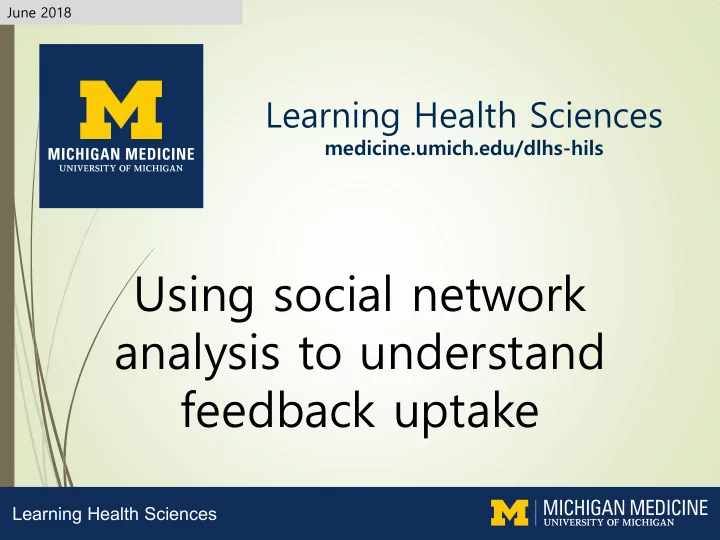

June 2018 Learning Health Sciences medicine.umich.edu/dlhs-hils Using social network analysis to understand feedback uptake Learning Health Sciences
Research collaborators were Carole Estabrooks Objectives and Tom Valente Reason for the study Identify the boundaries of the group Identify the relationship(s) of interest and propose mechanisms operating through the relationship(s) Collect data on the relationship through surveys or from archival sources Create a network visualization Analyze the network using descriptive or statistical methods Design an intervention to improve dissemination or accelerate behavior change The study described here was funded by the Canadian Institutes for Health Research, and conducted in Edmonton, Alberta in collaboration with Capitol Care, a long term care organization.
Study rationale Embedded within a 13 month feedback intervention study 2 organizations 4 facilities 9 long term care nursing units Study goal was to improve uptake of three evidence based practices Most prominent was pain assessment at every shift
Social network sub-study Boundaries Four nursing units in two LTC facilities What were we interested in? Wanted to know how people interacted with the feedback reports Uptake scale questions on a post-feedback survey on a monthly basis Asked who people talked to Needed to know more
Data collection Paper and pen survey instrument Listed names of everyone on each nursing unit Asked five network questions Who did you work with in the past 2 weeks? Who did you talk to at least once/day? Who did you discuss care of residents with? Who did you go to for advice about work issues? Who did you discuss the feedback report with? For this question, also asked whether discussing the report with this person Made me feel positive about the report Made me feel negative about the report Neither positive nor negative
More on data collection– how did we do? Blanketed each unit in each of the two facilities Had RAs at 6 am to catch night shift and day shifts RAs also went back around 3 pm to catch day and evening shifts Took food Either distributed survey to respondents or in some cases helped them complete the survey Ultimately achieved about 50% response rate Hard to really ascertain Lists of employees are complicated things Response rate varied from about 25% to about 75% depending on the unit
Visualizing the advice networks
Visualizing the feedback networks Page #
Comparing advice and feedback networks for the same unit is important Page #
Thinking about interventions Units appear to have very different networks for advice and discussing the feedback reports Different actors relating in different ways Suggests that advice was not necessarily the focus of discussion Focus only on CM (care manager/unit manager) in these two units One is very central; one is very peripheral Coaching for peripheral CM might be useful Considerable utility in deciding where to focus qualitative work to understand more about uptake and other issues Page #
Lessons learned This is very hard work Getting the response rates we did required multiple tries Hand delivered surveys four times each week (all shifts including midnight), one week each month for three months Time constraints, concerns about confidentiality, issues of lack of trust of managers However, this was timed for over 10 months into the intervention; RAs were very well known and relatively trusted We asked five network questions May have been too many List format of questionnaire may have been too long
Questions? Contact information: salesann@umich.edu Page #
Recommend
More recommend